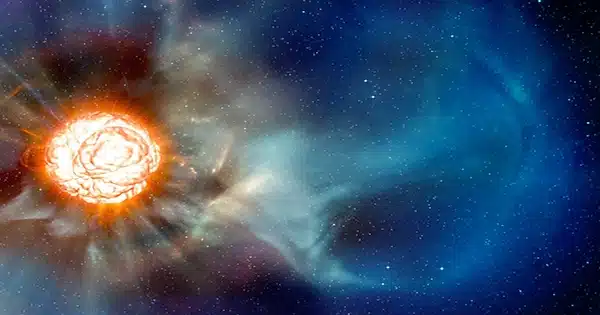In 2022, a massive star 16,000 light years away began inexplicably fading. After additional observations in 2023, a team of astronomers believes they have an explanation.
Stars are normally relatively stable constants in the sky when they aren’t causing green monsters or disappearing without a trace. With billions of years of existence, you can normally anticipate gazing at a star one day, then return to it a few weeks, months, or years later to find it with nearly the same brightness and characteristics as before.
However, this is the cosmos, and there are billions of stars to see, so it does not always work that way.
Stars have been observed fading, with many theories. Some light dips are caused by exoplanets orbiting the star, obscuring our view of it. This is how we hunt for exoplanets, and dips of this nature are not a mystery to astronomers.
Stars can also fade as they approach supernova. Betelgeuse has been inexplicably dimming on and off for years, and its pulsations indicate that an explosion is imminent. When it goes supernova, it will shine as brightly as a full moon. It’s unclear when that will occur, and the star isn’t helping by emitting clouds of dust, which have darkened the light from our perspective.
In 2022, RW Cephei revealed a dimming mystery of its own. A team from Georgia State University’s CHARA Array believes the “cool hypergiant” star is one of the Milky Way’s largest known stars. In the improbable case that it replaced our Sun, its outer layers would extend beyond Jupiter’s orbit. Changes in brightness emitted by elderly stars like this one are normally minor, thus astronomers were surprised when the star began to decline dramatically, comparable to Betelgeuse.
“We made our first CHARA observations in December 2022, just before the winter weather closure,” Georgia State University astronomer Narsireddy Anugu stated in a news statement. “But the results were so remarkable that we decided to pursue additional observations once the star was accessible again.”
Over a few years, the star had lost around one-third of its brightness. Observing it for ten months with the CHARA Array – six telescopes stretched across the mountainside of Mount Wilson, California – the team discovered that the star was not round and that its appearance altered dramatically as it began to brighten again.
Katherine Shepard, a student at Georgia State University, observed the star at wavelengths ranging from visible to infrared and discovered that the dimming was far greater in the visible range. This suggested to the researchers that the dimming was caused by an ejection that had turned to dust.
“We suggest that the maximum light time may have corresponded to a particularly energetic convective upwelling of hot gas that launched a surface mass ejection event,” the researchers stated in their report. “This gas is now cooling to the point of dust formation, and a portion of the ejected cloud seen in projection against the photosphere causes the western side of the star to appear darker.”
The period of such dimming occurrences may vary with star and dust cloud size, ranging from roughly a year in smaller Betelgeuse to several years larger RW Cep.”
According to the club, RW Cep’s “Great Dimming” could simply be the latest in a long line of ejections over the past century.
“This one was special because the cloud was ejected in the direction of Earth,” Gies continued, “so we were in the right place to witness the full effects of the cataclysm.”
















